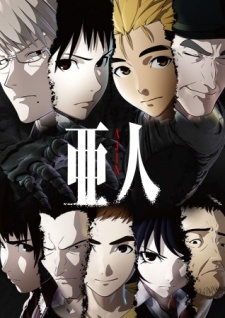
Ajin is what would have happened if Tokyo Ghoul revolved around a psychopath. Taking a similar story of a nerdy boy coming to terms with their identity as an inhuman monster, there is certainly a pervading sense that Ajin lives and thrives in the wake of Tokyo Ghoul’s success, but looking at the details we see a number of new choices, separations from its spiritual predecesor. For one, the subject Nagai Ken deals with the trauma of having his life turned inside out exactly the way one would reasonably expect: after holding on to his humanity and empathy for perhaps far too long, he closes off and drowns himself in pragmatism and self-utility. The other characters may be sadistic, but for the better part of the show Nagai doesn’t even allow himself that joy. If Ajin is a character study, then the character they chose is an odd beast indeed.
The monsters in question are the immortal Ajin, who walk and talk like ordinary people, get hurt and suffer long-term trauma like other people, and die like other people, but upon their death they come back to life in a matter of seconds, cured of any wounds and ailments aside from the pain of dying. For the most part, this is their defining characteristic, and were that the end of it most of them could be left alone as the harmless local freak show. But in Tuck Everlasting it's the man in the yellow coat seeking the secrets of immortality for profit, and in Ajin it's the government, ten times more sadistic and meticulous with their experimentation on the limits of Ajin pain and death. With the profit margins somewhat ill-defined and certainly not enough to excuse the fanatical torture exacted on Ajin, the show moves to plan B: some of the Ajin carry within them a wispy black ghost, invisible to most humans but fully capable of wanton destruction and murder. With the Knights of Sidonia-esque 3D animation style, Ajin renders the ghosts both wistfully and menacingly, giving them echoed voices and a constant stream of darkness emanating from their person. Now we’ve got a fair fight, not to mention an excuse for setting up some pretty messed up machinations from both sides.
As we follow Nagai’s journey into hiding, capture, escape, and back into hiding, we also witness the beginnings of a grand plan by a mysterious Ajin named Satou, exploiting Nagai’s celebrity status as the third publicly discovered Ajin in Japan to put out a call for the disgruntled and terrified Ajin masses to come together and take control of their own destinies. Of course we also spend most of that time watching Satou play with both sides a bit to get things riled up, and quickly we come to the conclusion that his only real goal is to get the chance to kill as many people as he wants, with the biggest audience available. It's interesting how well his comrades manage to synchronize with his planning and motivations, and during the fight scenes and eventual realization of his plans in the latter half of the show the Ajin revolutionaries function like a very tight, controlled, and adaptive organization rather than a rag-tag bunch of immortal social misfits with a few weeks of plotting. It’s enough to make the government look pretty disheveled at the least.
In fact, at times it becomes questionable where the central conflict really lies. Nagai and Satou certainly don’t get along, but once Nagai escapes from the police and goes out into the countryside to live a quiet peaceful life there’s no longer much of a fight to be had between them. It could be Satou versus society, except that at best there's one, maybe two scenes where the latter puts up a good fight. The chief investigator for the government Tosaki is in constant conflict with both his allies and his enemies, with a curt personality and obsession with catching the Ajin, but ultimately his character amounts to a whole lot of sputtering and yelling without a ton of payoff, although he does prove a fairly consistent nuisance to Nagai’s peaceful life away from the public eye. Part of the issue with resolving this question is the fact that the show itself ends just as everything is getting started, not unsatisfyingly or on a cliffhanger but certainly not with any sense of a final confrontation or ultimate resolution to be had.
The most convincing argument that I could think of was that the central conflict of Ajin is between Nagai and the external world, both the sympathetic and the antagonistic. He lives a human life in the countryside, masquerading as a reformed delinquent and grandson to one of the local women, but for every scene of his gentle smile or chatting with his grandmother there is another where he mentally dismisses the value of the people around him, if not attacking them for personal gain. Before his capture and subsequent escape in the show's front half, he got by with the help of a childhood friend named Kaito, but in no time flat Nagai makes a seemingly arbitrary decision to knock Kaito out, steal his phone, and cut him from the show completely. Even though during his time as a police captive he would prove time and time again that he still had the morality to not attack the experimenters torturing and killing him endlessly, with his pragmatic change of heart in the Kaito case and his pervasive use of a mechanically flat voice, it’s pretty clear that his empathy—or rather, his humanity—was already walking a thin line.